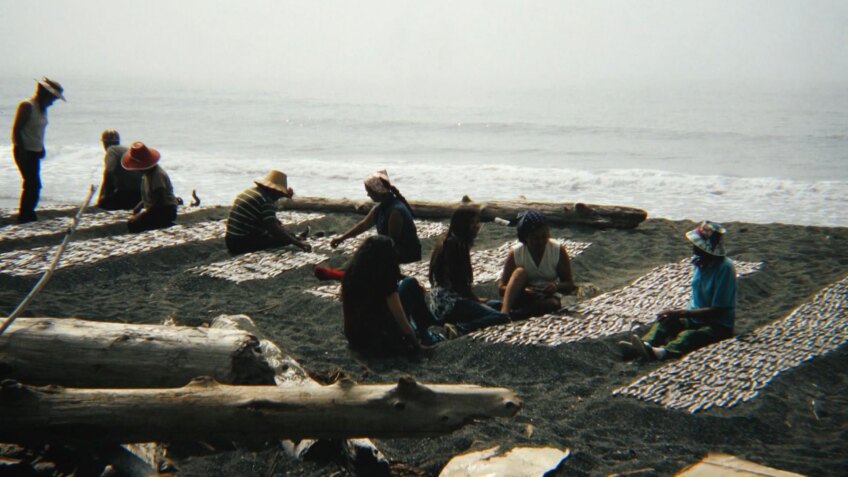The Tolowa People Work With Western Science to Monitor Coastal Health

We tend to think of environmental protection in terms of the sciences, namely western biology and western ways of knowing. We go to universities to learn about the natural and cultural world around us but fail at times to recognize the world prior to colonization and the devastating environmental changes that have occurred because of it.
Since time immemorial the Tolowa Dee-ni’ people of Northwestern California have fished, cared for, and tended the coastal environment. The Pacific Ocean and coastline is a fundamentally important cultural space for subsistence fishing and traditional gathering for the Tolowa Dee-ni’ people. The Tolowa have a special relationship with the sea, an understanding that has stretched back for generations. Along with smelt of the coast, the Tolowa people also depended on seaweed harvest, mussels, salmon, eel, and deer from the surrounding environment.
Environmental protection as we know it today is the result of colonization that has worked to remove Indigenous knowledge away from the environment. The Tolowa Dee-ni' people, along with other Northwestern California tribes such as the Hupa and Yurok, have worked to ensure that their traditional ecological knowledge is privileged within western science. Despite fraught relationships with state land managers, tribal nations such as the Tolowa are working with state, local, and federal agencies to monitor environmental health on the coast.

The Tolowa Dee-ni’ Nation is currently working with the California Department of Public Health (CDPH) on ongoing monitoring of razor clam and shellfish samples, two important subsistence foods for the Tolowa. The Tolowa submit razor clams and mussels to CDPH to inspect for natural occurring marine toxins that help inform local and statewide fish advisories and notices. Domoic acid is a naturally occurring toxin that can be harmful if they reach a “bloom” phase. Fish, shellfish, and crustaceans can reach elevated bloom phase of pseudo-nitzschia and Alexandrium. While this does not produce negative effects on the animals, it poses significant public health problems in humans.
The effects of ingesting toxic razor clams and mussels are immediate and dangerous. Symptoms of domoic acid poisoning occur within 24 hours after eating contaminated seafood. Mild symptoms may include headache, dizziness, vomiting, abdominal cramps, and diarrhea, and can last a several days. Severe cases may include trouble breathing, confusion, cardiovascular instability, seizures, bronchial secretions, permanent loss of short-term memory (amnesic shellfish poisoning), coma or death.
In addition to domoic acid poisoning, paralytic shellfish poisoning is also a potential risk factor on the coast. Symptoms of this include, tingling, numbness of the lips, tongue and fingertips, lack of balance, lack of muscle coordination, slurred speech and problems swallowing. Death or complete paralysis may occur in severe cases. The health risks are are heightened in communities, such as the Tolowa Dee-ni’, that depend on subsistence fishing to practice traditional culture and livelihood.
The Tolowa Dee-ni’ are a part of a network of coastal communities supported by the Marine Biotoxin Monitoring Program at CDPH that has been monitoring biotoxins since a 1927 paralytic shellfish poisoning (PSP) episode related to mussel consumption, resulting in several deaths. Domoic acid has been monitored since their discovery in California marine environment in 1991. The program depends on the participation of various local, state, and federal agencies, Tribal biologists, educational organizations, and citizen scientists to collect shellfish samples and send them to the CDPH laboratory in Richmond, CA for monitoring. The specimens are then tested for biotoxin rates to determine ingestion risks for communities on the coast. Commercial shellfish and mussel operations are required to send specimens to the Richmond lab at least weekly.
Much of the problems that have stemmed from biotoxins come from climate change. The warming sea has increased the risk of blooms in mussels and razor clams. While the Tolowa have been active participants of the monitoring program, they have been tending their environment since time immemorial. Environmental protection and management to the tribes of Northern California is not merely about scientific knowledge of the environment. Rather, traditional ecological knowledge focuses on both the spiritual as well as cultural investment in protecting the environment. It is the difference between “resource” management and “relationship” management. The Tolowa Dee-ni’ along with other tribes of the north coast, understand that humans are as much a part of the environment as any other animal or plant, and to maintain balance we must have a loving, non-extractive relationship with the Earth.
Western science practices have often positioned humans as the overseers of the environment rather than an integral part of it. Traditional ecological knowledge requires that Indigenous knowledge be placed at the forefront of understanding the surrounding environment. We must understand and respect the traditional cultures of Indigenous people who have formed deep relationships with the land. Rather than data collection, the Tolowa Dee-ni’ focus their care of marine life through a holistic vision. This holistic vision includes all of the seven generations, those who align us with our past to those who lead us to our futures. With the partnership to the biotoxin program, the Tolowa Dee-ni’ are ensuring that their people can safely fish and eat without harm for the immediate future.

